Dikeou Superstars: Rainer Ganahl’s “Seminars/Lectures”

A person attends a lecture or seminar usually for one of two reasons: he or she is required to go for work or academic purposes, or the person chooses to go out of their own personal interest. People from both situations comprise the audience for these gatherings, thus creating a mixture of those who are energized and engaged and those who are antsy and bored. Moods change, though, and someone can leave with the opposite impression than when they arrived. For twenty years, Rainer Ganahl has attended hundreds of seminars and lectures and photographed the speakers and their respective audiences, which has become his aptly titled “Seminars/Lectures,” or “S/L” series. The Dikeou Collection is home to fourteen of these photo sets, which date from the early days of the series and serve as a document not just of Ganahl’s own intellectual interests, but of the zeitgeist of that particular decade. This project also appeared in issue 15 of zingmagazine , with accompanying text by AS Bessa. This fall recent photographs from “S/L” were exhibited at Kai Matsumiya, which highlighted the artist’s persistent quest for knowledge and dedication to the project, as well as the current intellectual, cultural, and social climates of our time. When someone like Ganahl places themselves in the roles of spectator and artist simultaneously within the speaker-audience exchange, the resulting imagery adds new layers of value and interpretation to the event.


Rainer Ganahl, “Seminars / Lectures
Linda Nochlin, Glory and Misery of Pornography,” 1996, 20” x 24", edition 2/2
The documentation and dissemination of lecture material is rampant these days thanks to the internet, with a special nod to YouTube which now has more than 2,000 TED Talks and countless other lectures available to view. Often the camera will zoom out from behind or to the side of the speaker to show the audience, but all that is seen is rows of shoulders and heads - the audience has no identity or personality. “S/L,” though, gives equal attention to the audience and speaker by allowing each to have their own photograph. This mode of presentation also highlights Ganahl’s interest in the Socratic dialogue, or method, in which there is a dualistic exchange to stimulate critical thinking and illuminate ideas.

Socrates is credited as being one of the founders of Western philosophy, particularly his contributions to the field of ethics. Plato was his greatest student and did much to document his life and teachings. This 17th-century Italian engraving by Johann Friedrich Greuter shows Socrates surrounded by students outdoors where they are not distracted or troubled by the everyday activities happening in the background. The scene can be a metaphor for Socrates’ belief that only the trained mind is prepared to see beneath the deceptive appearances of the words and actions of others to the deeper realities of life. The relationship between instructor and student is rich subject matter for artists as it can take shape in numerous contexts over history.

The idea of “formal education” as we know it today developed in the medieval period and evolved from much older Christian cathedral schools and monastic schools. The setting for Laurentius de Voltolina’s Italian 14th-century painting appears to be inside a church or monastery, and shows that not much has changed in the classroom since medieval times. Teachers’ pets in the front, slackers in the back.
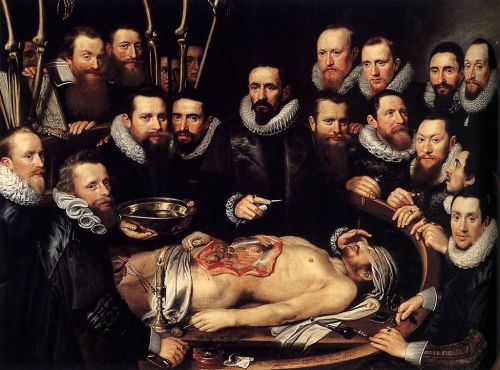
Pieter Mierevelt’s Anatomy lesson of Dr. Willem van der Meer predates Rembrandt’s Anatomy Lesson of Dr. Nicolaes Tulp by fourteen years and was a likely inspiration for the famous work. Mierevelt’s painting gives a clear look at the instruments and the pupils look straight at the viewer as if they are part of the lesson. This image speaks to Ganahl’s aims to dissolve the barriers between teacher, audience, and artist. Anyone else up for some spaghetti and meatballs after class?
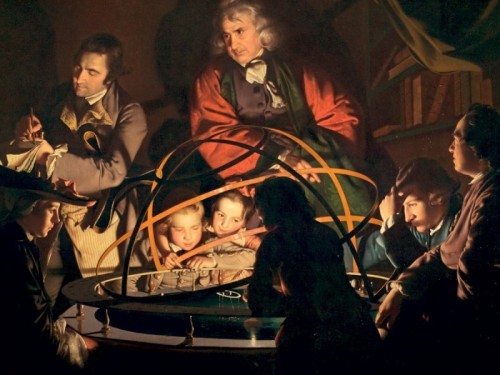
Ganahl would find a likely kindred spirit with Joseph Wright of Derby who depicted many forms of learning in his art. Whether it be in the realms of science and astronomy, or art and literature, Derby beautifully captured the wonderment and joy of learning in his subjects. A Philosopher Lecturing on the Orrey is representative of the Age of Enlightenment, or Age of Reason, that started in 1766 when this painting was made, where the illumination of the mind is reinforced with the striking light in the scene. Scientific lectures and demonstrations presented by traveling scientists were a popular form of public entertainment during Wright’s lifetime, and, like Ganahl, he likely attended these lectures for his own personal enjoyment and inspiration.
[caption id="attachment_4688" align="alignnone" width="500"]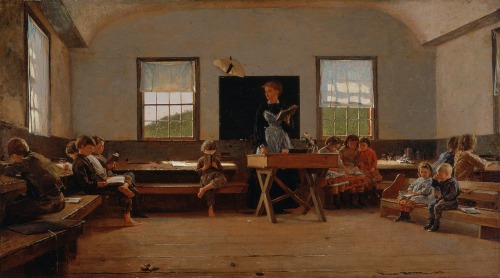 STM620298; Saint Louis Art Museum, Missouri, USA; out of copyright[/caption]
STM620298; Saint Louis Art Museum, Missouri, USA; out of copyright[/caption]
Education for children in America was established during the colonial era and was available only to boys, but co-ed classrooms gained prevalence in the late-18th century. Winslow Homer’s Country Classroom from 1871 depicts a single-room school in the Catskills. Though there are both boys and girls present, they are still seated at opposite sides of the room with the exception of the crying boy sitting with the girls. This time period is when most women were able to work outside the home for the first time, and schoolteaching was popular as it seemed to fit into their “womanly duties.”
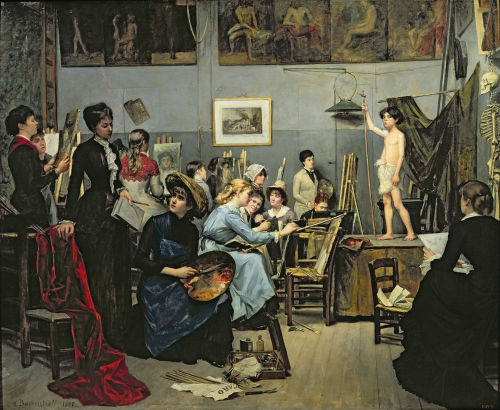
Speaking of womanly duties, only women were allowed to instruct other women in art classes in the 19th century because art made and taught by men was much too serious and important to be concerned with the opposite sex. Marie Bashkirtseff’s In the Studio from 1881 carries a tension that emanates from the instructor and one of the students, a feeling to which many art students can relate. The young model in this figure class looks directly at the viewer as if he can sense the tension as well, breaking that invisible artist-subject and subject-viewer barrier with a look that implies, “I can’t believe she just said that.”
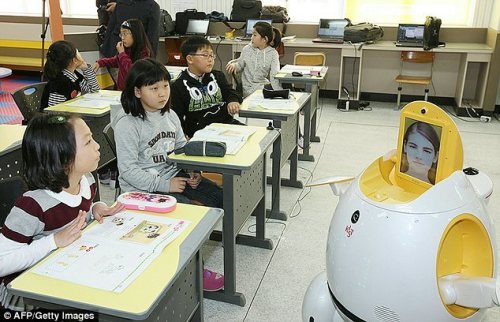
Flash forward to the not-so-distant future where outsourced teaching will become the norm. “Engkey” is a robot technology that teachers can access remotely. There are about 30 of these robots in use in South Korea right now, teaching English to primary school kids. Technology is becoming more prevalent in education all the time, and while it can be useful in helping students access information quickly, there is no guarantee in its ability to help students retain this information. There is something to be said about the connection that can only be established through person to person interaction, a crucial aspect in creating memories and making cognitive connections, which is how real learning happens. The day will surely come when robots will be regular fixtures in our homes, workplaces, and schools, but hopefully it will not get to the point where we forget how to teach ourselves and become dependent on machines for knowledge.
Surely Rainer Ganahl would be present for the day that a robot gives a lecture to an audience of humans for the first time for the ever-growing “S/L” series, but for now we can still enjoy the images he captures of humanity today.
“Artists - Recent Photographs from My S/L Series” is on view at Kai Matsumiya through November 1, 2015.
— Hayley Richardson
